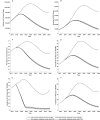Forecasted impacts of a sofosbuvir-based national hepatitis C treatment programme on Egypt's hepatocellular cancer epidemic: simulation of alternatives
- PMID: 29707244
- PMCID: PMC5914708
- DOI: 10.1136/bmjgh-2017-000572
Forecasted impacts of a sofosbuvir-based national hepatitis C treatment programme on Egypt's hepatocellular cancer epidemic: simulation of alternatives
Abstract
Background: Egypt is experiencing a hepatocellular cancer (HCC) epidemic due to widespread hepatitis C virus (HCV) transmission. The use of sofosbuvir-related therapies producing improved treatment success has permitted an updated, nationwide, HCV treatment programme with expanded coverage. This study simulated the multidecade impacts of the new treatment programme on hepatitis and HCC.
Methods: A Markov model of HCV infection and treatment analysed the HCV-related HCC epidemic between 2009 and 2050, using parameters based on peer-reviewed studies and expert opinion. Comparing the 'new' and 'old' scenarios, and with the old treatment programme being replaced or not by the new programme in 2015, the annual number, prevalence and incidence of HCC were simulated for representative Egypt populations including HCV-infected patients aged 15-59 years in 2008, healthy people aged 5-59 years in 2008 and 5-year-old children cohorts entering the population each year beginning in 2009. Averted HCC cases were calculated, and sensitivity analyses were performed.
Results: Compared with the old scenario, the estimated number, prevalence and incidence of future HCC cases in the new scenario would peak earlier and at lower levels in 2025 (~29 000), 2023 (~28/100 000) and 2022 (~14/100 000), respectively. The new treatment programme is estimated to avert ~956 000 HCC cases between 2015 and 2050.
Discussion: By reducing cancer cases and shortening the peak epidemic period, the new programme should substantially diminish the HCC epidemic across Egypt. Our timeline forecast for Egypt's HCC epidemic, and evaluation of various disease and programme components, should be useful to other countries that are developing policies to address HCV-related liver cancer prevention.
Keywords: HCV; Liver cancer; disease burden; hepatitis C; hepatocellular cancer; simulation.
Conflict of interest statement
Competing interests: None declared.
Figures





References
-
- World Health Organization. World cancer report 2014. Lyon: International Agency for Research on Cancer, 2014.
-
- Eldin I, Hablas A, Ramadan M, et al. . Cancer incidence in five continents (Egypt, Gharbiah) : Steliarova-Foucher E, Ferlay J, Forman D, Cancer incidence in five continents. Lyon, France: International Agency for Research on Cancer, 2014:128–9.
-
- Ministry of Health E, El-Zanaty and Associates E, Internaitonal I. Egypt health issues survey. Cairo, Egypt and Rockville, Maryland, USA: Ministry of Health and Population and ICF International, 2015.
Grants and funding
LinkOut - more resources
Full Text Sources
Other Literature Sources
